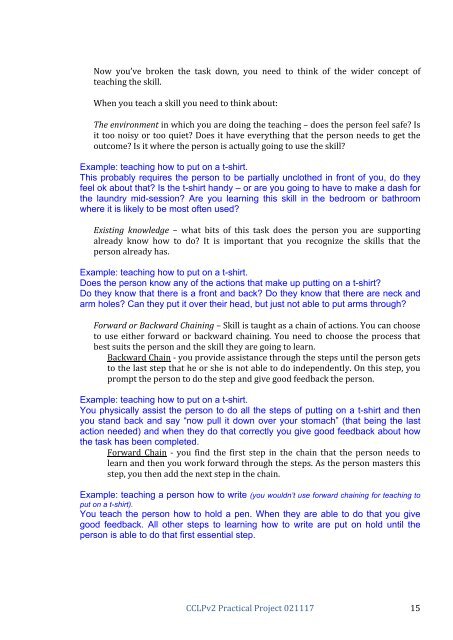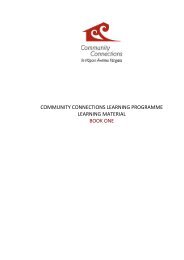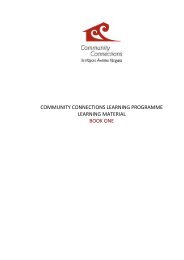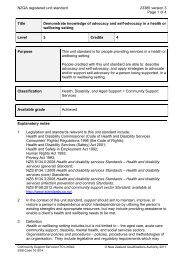CCLP PROJECT Learner (011117)
Create successful ePaper yourself
Turn your PDF publications into a flip-book with our unique Google optimized e-Paper software.
Now you’ve broken the task down, you need to think of the wider concept of <br />
teaching the skill. <br />
When you teach a skill you need to think about: <br />
The environment in which you are doing the teaching – does the person feel safe? Is <br />
it too noisy or too quiet? Does it have everything that the person needs to get the <br />
outcome? Is it where the person is actually going to use the skill? <br />
Example: teaching how to put on a t-shirt.<br />
This probably requires the person to be partially unclothed in front of you, do they<br />
feel ok about that? Is the t-shirt handy – or are you going to have to make a dash for<br />
the laundry mid-session? Are you learning this skill in the bedroom or bathroom<br />
where it is likely to be most often used?<br />
Existing knowledge – what bits of this task does the person you are supporting <br />
already know how to do? It is important that you recognize the skills that the <br />
person already has. <br />
Example: teaching how to put on a t-shirt.<br />
Does the person know any of the actions that make up putting on a t-shirt?<br />
Do they know that there is a front and back? Do they know that there are neck and<br />
arm holes? Can they put it over their head, but just not able to put arms through?<br />
Forward or Backward Chaining – Skill is taught as a chain of actions. You can choose <br />
to use either forward or backward chaining. You need to choose the process that <br />
best suits the person and the skill they are going to learn. <br />
Backward Chain -‐ you provide assistance through the steps until the person gets <br />
to the last step that he or she is not able to do independently. On this step, you <br />
prompt the person to do the step and give good feedback the person. <br />
Example: teaching how to put on a t-shirt.<br />
You physically assist the person to do all the steps of putting on a t-shirt and then<br />
you stand back and say “now pull it down over your stomach” (that being the last<br />
action needed) and when they do that correctly you give good feedback about how<br />
the task has been completed.<br />
Forward Chain -‐ you find the first step in the chain that the person needs to <br />
learn and then you work forward through the steps. As the person masters this <br />
step, you then add the next step in the chain. <br />
Example: teaching a person how to write (you wouldn’t use forward chaining for teaching to<br />
put on a t-shirt).<br />
You teach the person how to hold a pen. When they are able to do that you give<br />
good feedback. All other steps to learning how to write are put on hold until the<br />
person is able to do that first essential step.<br />
<strong>CCLP</strong>v2 Practical Project 021117 <br />
15





